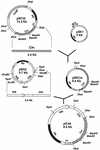Characterization of the rrnB operon of the plant pathogen Rhodococcus fascians and targeted integrations of exogenous genes at rrn loci
- PMID: 9546162
- PMCID: PMC106141
- DOI: 10.1128/AEM.64.4.1276-1282.1998
Characterization of the rrnB operon of the plant pathogen Rhodococcus fascians and targeted integrations of exogenous genes at rrn loci
Abstract
A 6.0-kb SalI DNA fragment containing an entire rRNA operon (rrnB) was cloned from a cosmid gene bank of the phytopathogenic strain Rhodococcus fascians D188. The nucleotide sequence of the 6-kb fragment was determined and had the organization 16S rRNA-spacer-23S rRNA-spacer-5S rRNA without tRNA-encoding genes in the spacer regions. The 5' and 3' ends of the mature 16S, 23S, and 5S rRNAs were determined by alignment with the rrn operons of Bacillus subtilis and other gram-positive bacteria. Four copies of the rrn operons were identified by hybridization with an rrnB probe in R. fascians type strain ATCC 12974 and in the virulent strain R. fascians D188. However, another isolate, CECT 3001 (= NRRL B15096), also classified as R. fascians, produced five rrn-hybridizing bands. An integrative vector containing a 2.5-kb DNA fragment internal to rrnB was constructed for targeted integration of exogenous genes at the rrn loci. Transformants carrying the exogenous chloramphenicol resistance gene (cmr) integrated in different rrn operons were obtained. These transformants had normal growth rates in complex medium and minimal medium and were fully stable for the integrated marker.
Figures





Similar articles
-
Localization and structural analysis of the ribosomal RNA operons of Rhodobacter sphaeroides.Nucleic Acids Res. 1990 Dec 25;18(24):7267-77. doi: 10.1093/nar/18.24.7267. Nucleic Acids Res. 1990. PMID: 1701878 Free PMC article.
-
Nucleotide sequences of the spacer-1, spacer-2 and trailer regions of the rrn operons and secondary structures of precursor 23S rRNAs and precursor 5S rRNAs of slow-growing mycobacteria.Microbiology (Reading). 1994 Jul;140 ( Pt 7):1763-73. doi: 10.1099/13500872-140-7-1763. Microbiology (Reading). 1994. PMID: 7521248
-
Organization of ribosomal RNA genes from the footrot pathogen Dichelobacter nodosus.Microbiology (Reading). 1996 Apr;142 ( Pt 4):889-899. doi: 10.1099/00221287-142-4-889. Microbiology (Reading). 1996. PMID: 8936315
-
Reprint of New opportunities for improved ribotyping of C. difficile clinical isolates by exploring their genomes.J Microbiol Methods. 2013 Dec;95(3):425-40. doi: 10.1016/j.mimet.2013.09.009. Epub 2013 Sep 16. J Microbiol Methods. 2013. PMID: 24050948 Review.
-
Can whole genome analysis refine the taxonomy of the genus Rhodococcus?FEMS Microbiol Rev. 2004 Jun;28(3):377-403. doi: 10.1016/j.femsre.2004.01.001. FEMS Microbiol Rev. 2004. PMID: 15449609 Review.
Cited by
-
rRNA operon copy number reflects ecological strategies of bacteria.Appl Environ Microbiol. 2000 Apr;66(4):1328-33. doi: 10.1128/AEM.66.4.1328-1333.2000. Appl Environ Microbiol. 2000. PMID: 10742207 Free PMC article.
-
Genetic Engineering of Crypthecodinium cohnii to Increase Growth and Lipid Accumulation.Front Microbiol. 2018 Mar 19;9:492. doi: 10.3389/fmicb.2018.00492. eCollection 2018. Front Microbiol. 2018. PMID: 29616006 Free PMC article.
-
The effective expression of xylanase gene in Candida utilis by 18S rDNA targeted homologous recombination in pGLR9K.Mol Biol Rep. 2010 Jul;37(6):2615-20. doi: 10.1007/s11033-009-9786-x. Mol Biol Rep. 2010. PMID: 19731075
-
Construction of a xylanase-producing strain of Brevibacterium lactofermentum by stable integration of an engineered xysA gene from Streptomyces halstedii JM8.Appl Environ Microbiol. 2001 Dec;67(12):5425-30. doi: 10.1128/AEM.67.12.5425-5430.2001. Appl Environ Microbiol. 2001. PMID: 11722888 Free PMC article.
References
-
- Amador, E., J. M. Castro, A. Correia, and J. F. Martín. Unpublished data.
-
- Bathe B, Kalinowsky J, Puhler A. A physical and genetic map of the Corynebacterium glutamicum ATCC 13032 chromosome. Mol Gen Genet. 1996;252:255–265. - PubMed
-
- Brosius J, Dull T J, Sleeter D D, Noller H F. Gene organization and primary structure of a ribosomal RNA operon from Escherichia coli. J Mol Biol. 1981;148:107–127. - PubMed
Publication types
MeSH terms
Substances
Associated data
- Actions
LinkOut - more resources
Full Text Sources
Other Literature Sources
Molecular Biology Databases

